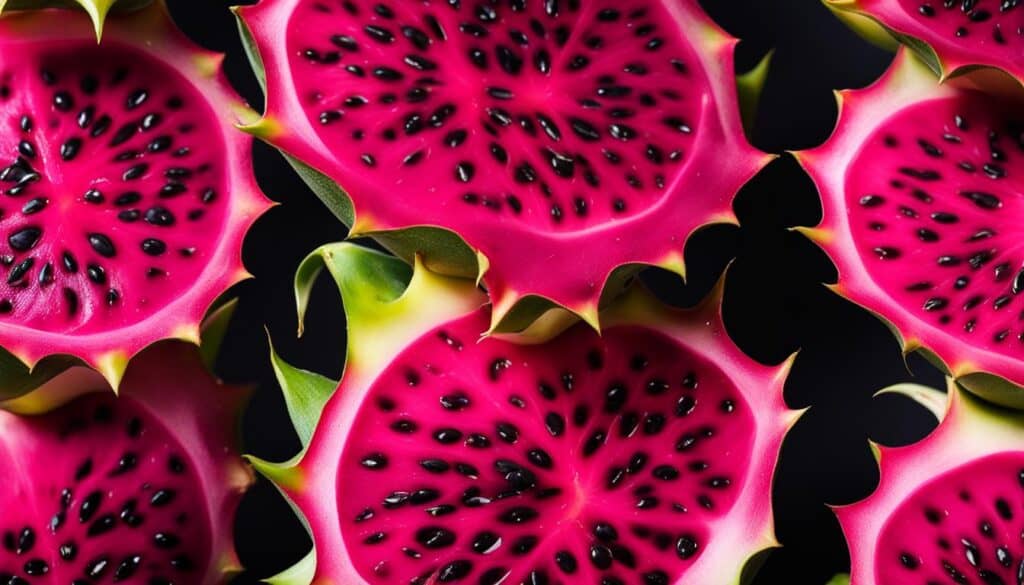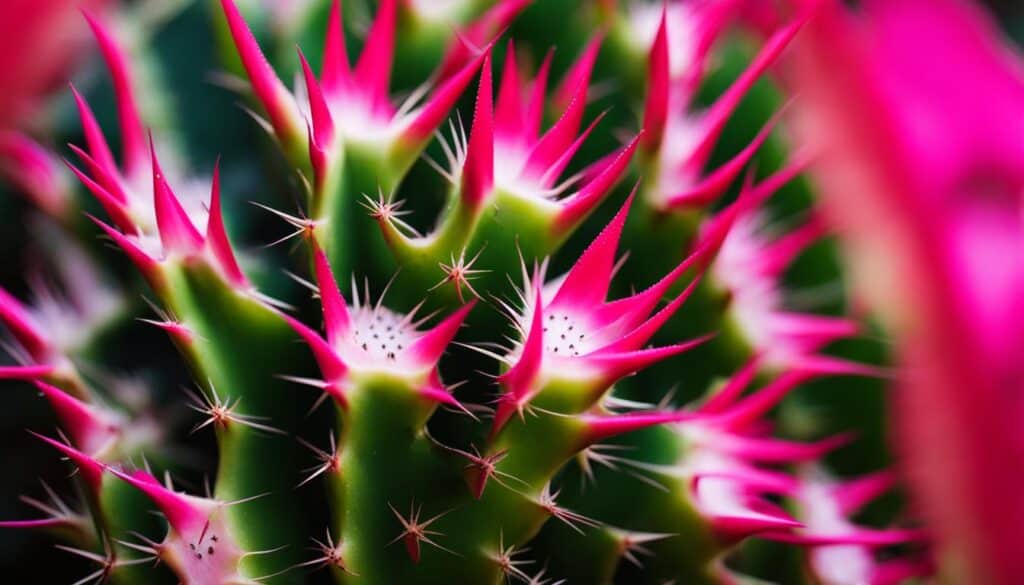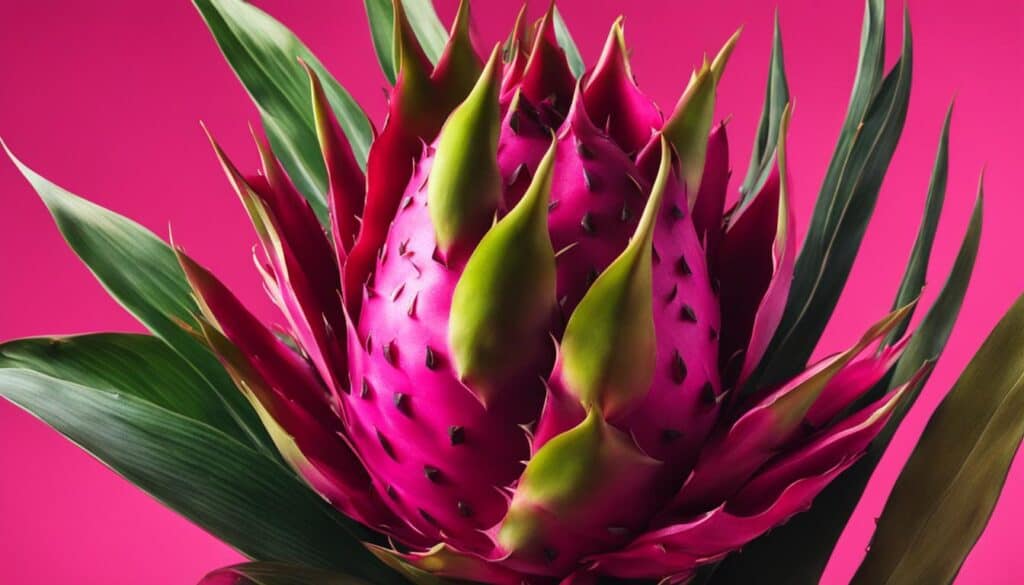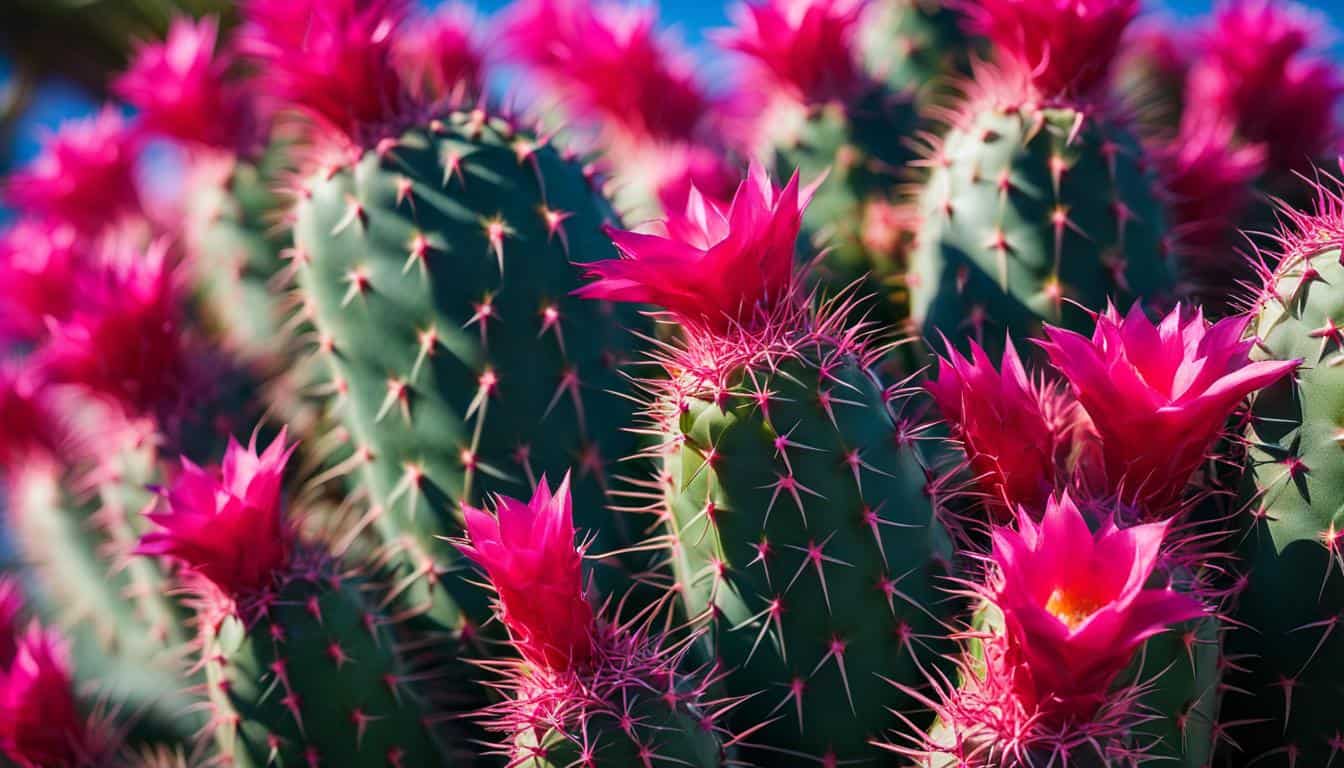Welcome to the fascinating world of Selenicereus Undatus, also known as the Dragon Fruit Cactus. This exotic fruit has captivated the hearts and taste buds of people around the globe. From its stunning beauty to its array of health benefits, there’s no doubt that Selenicereus Undatus is a tropical treasure worth exploring.
Key Takeaways:
- Selenicereus Undatus, also known as the Dragon Fruit Cactus, is an exotic fruit with unique attributes.
- Dragon fruit is prized for its spectacular beauty, with sprawling branches and nocturnal flowers.
- The fruit itself is a feast for the senses, with a vibrant appearance and a sweet, subtle flavor.
- Dragon fruit offers a range of health benefits, including being rich in vitamin C, fiber, and antioxidants.
- Cultivating dragon fruit is relatively easy, making it a popular choice for home gardeners.
The Spectacular Beauty of Selenicereus Undatus
Selenicereus Undatus, also known as the Dragon Fruit Cactus, is not only a fascinating plant but also a sight to behold. With its sprawling branches and breathtaking flowers, it adds a dramatic touch to any garden or landscape.
The most remarkable feature of Selenicereus Undatus is its large, white flowers that bloom at night. These nocturnal flowers emit a delightful fragrance that attracts pollinators such as bats and moths. The flowers are a spectacle in themselves, opening for just one night before closing again.
Its unique characteristics make Selenicereus Undatus a truly spectacular addition to any garden. The combination of its sprawling branches and the enchanting beauty of its nocturnal flowers make it a captivating plant that is sure to impress.
The Spectacular Beauty of Selenicereus Undatus
Selenicereus Undatus, also known as the Dragon Fruit Cactus, is not only a fascinating plant but also a sight to behold. With its sprawling branches and breathtaking flowers, it adds a dramatic touch to any garden or landscape.
The most remarkable feature of Selenicereus Undatus is its large, white flowers that bloom at night. These nocturnal flowers emit a delightful fragrance that attracts pollinators such as bats and moths. The flowers are a spectacle in themselves, opening for just one night before closing again.
Its unique characteristics make Selenicereus Undatus a truly spectacular addition to any garden. The combination of its sprawling branches and the enchanting beauty of its nocturnal flowers make it a captivating plant that is sure to impress.
The Dragon Fruit: A Feast for the Senses
The fruit produced by Selenicereus Undatus, commonly known as dragon fruit or pitaya, is a feast for the senses. Its unique appearance and flavorful taste make it a popular choice among fruit lovers. The dragon fruit has a vibrant pink or white outer skin with large, leaf-like scales, giving it a dragon-like appearance. Inside, the flesh is dotted with tiny black seeds and can vary in color – white, pink, or red.
Not only does the dragon fruit look visually appealing, but it also has a sweet and subtle flavor. This makes it a versatile ingredient that can be used in various culinary creations. From fruit salads to smoothies, desserts to cocktails, the dragon fruit adds a burst of color and a delightful taste to any dish. Its tropical flavor profile is a favorite among those who appreciate exotic fruits.
When it comes to the nutritional aspects, dragon fruit is no disappointment. It is rich in vitamins, minerals, and antioxidants, making it a healthy choice for any diet. The fruit is known to be a good source of vitamin C, fiber, and antioxidants, which can provide a range of health benefits. Incorporating dragon fruit into your meals can help boost your immune system, improve digestion, and potentially prevent chronic diseases.

In conclusion, the dragon fruit is not only visually stunning but also a flavorful and nutritious tropical fruit. Its unique appearance, sweet taste, and potential health benefits make it a favorite among fruit enthusiasts. Whether you enjoy it fresh or incorporate it into various recipes, the dragon fruit is sure to delight your senses and add a touch of exoticism to your culinary adventures.
Unraveling the Nutritional and Health Benefits of Dragon Fruit
Dragon fruit, also known as Selenicereus Undatus, is not just visually stunning but also packed with essential nutrients that can benefit your health. This tropical fruit is not only delicious but also offers a range of health advantages that make it a great addition to your diet.
The Power of Vitamin C
One of the key health benefits of dragon fruit is its high vitamin C content. Vitamin C is a potent antioxidant that helps protect your cells from damage caused by free radicals. It also supports a healthy immune system and aids in collagen production, promoting healthy skin and joint health.
Fiber for Digestive Health
Dragon fruit is an excellent source of dietary fiber, which is essential for maintaining a healthy digestive system. Fiber adds bulk to your stool, promoting regular bowel movements and preventing constipation. Additionally, it helps nourish the beneficial bacteria in your gut, supporting overall gut health.
Antioxidant-Rich for Overall Wellness
Antioxidants are compounds that help neutralize harmful free radicals in the body, reducing the risk of chronic diseases and supporting overall wellness. Dragon fruit contains several antioxidants, including betalains, flavonoids, and carotenoids, which have been linked to a lower risk of heart disease, certain cancers, and inflammation.
To fully reap the health benefits of dragon fruit, it is best to incorporate it into your regular diet. Whether you enjoy it on its own, as part of a fruit salad, or blended into a refreshing smoothie, this exotic fruit can add a burst of flavor and nutrition to your meals.
| Nutrient | Amount per 100g |
|---|---|
| Calories | 60 |
| Carbohydrates | 9g |
| Fiber | 1g |
| Protein | 1g |
| Fat | 0g |
| Vitamin C | 20% of the recommended daily intake |
| Calcium | 1% of the recommended daily intake |
| Iron | 4% of the recommended daily intake |
As shown in the table above, dragon fruit is low in calories and fat while offering a good amount of carbohydrates and fiber. It also provides a notable dose of vitamin C, making it a nutrient-rich choice for those looking to boost their overall well-being.
Cultivation and Growth of Selenicereus Undatus
Selenicereus Undatus, also known as the Dragon Fruit plant, is relatively easy to cultivate and propagate. Whether you’re a seasoned gardener or a beginner, growing your own dragon fruit plant can be a rewarding experience. Here are some key tips to help you successfully nurture and grow this unique and exotic fruit.
Choosing the Right Location and Soil
Dragon fruit plants thrive in warm and tropical climates, so it’s important to choose a suitable location for cultivation. They require plenty of sunlight, so select a spot in your garden that receives at least six hours of direct sunlight each day. As for the soil, dragon fruit plants prefer well-draining soil with a slightly acidic pH level. Adding organic matter, such as compost or well-rotted manure, can help improve soil fertility and drainage.
Propagation Methods
The easiest way to propagate Selenicereus Undatus is through stem cuttings. Select a healthy stem from an established plant and carefully remove it using clean, sharp shears. Allow the cutting to dry for a few days before planting it in a well-draining potting mix. Keep the soil moist but not overly wet, and within a few weeks, you should start to see new growth. Once the cutting has developed a strong root system, you can transfer it to a larger container or directly into the ground.
Watering and Fertilization
Dragon fruit plants require regular watering, especially during the growing season. However, it’s important to avoid overwatering as this can lead to root rot. Allow the top inch of soil to dry out between waterings, and adjust the frequency based on the weather conditions and moisture levels. When it comes to fertilization, a balanced fertilizer formulated for cacti and succulents can provide the necessary nutrients for healthy growth. Apply the fertilizer according to the manufacturer’s instructions, usually once a month during the growing season.
| Aspect | Cultivation Tips |
|---|---|
| Sunlight | Choose a location with at least six hours of direct sunlight each day. |
| Soil | Opt for well-draining soil with a slightly acidic pH level. Enhance soil fertility with organic matter. |
| Propagation | Propagate through stem cuttings, allowing them to dry for a few days before planting. |
| Watering | Water regularly, allowing the top inch of soil to dry between waterings. |
| Fertilization | Apply a balanced fertilizer formulated for cacti and succulents once a month during the growing season. |
With proper care and attention, your Selenicereus Undatus plant will flourish and reward you with its beautiful flowers and delicious fruit. So, why not embark on the journey of cultivating your own dragon fruit plant and savor the joys of homegrown exotic fruits?
The Wonder of Overnight Growth
Selenicereus Undatus, also known as the Dragon Fruit Plant, never fails to astound with its ability to experience rapid overnight growth. It is truly a wonder of nature. Many growers have reported witnessing their plants grow several inches in just one night. This phenomenon showcases the incredible power of plant growth and leaves us in awe of nature’s intricate workings.
The exact reasons behind this overnight growth spurt are not fully understood. However, it is believed to be influenced by various factors such as optimal environmental conditions, sufficient water and nutrient supply, and the plant’s natural growth cycle. It is a fascinating process that highlights the resilience and adaptability of Selenicereus Undatus.
The Intricacies of Overnight Growth
While the specifics of overnight growth remain somewhat elusive, it is clear that the Dragon Fruit Plant possesses a remarkable ability to rapidly expand and develop during the nighttime hours. This growth spurt is often observed during the plant’s active growth phase, which typically occurs in the warmer months. The plant takes advantage of the darkness and cooler temperatures to channel its energy into extensive growth, manifesting in noticeable height and branch increases.
Quote: “Seeing my Dragon Fruit Plant grow inches overnight is like witnessing a miracle. It’s a testament to the beauty and mystery of nature.” – Passionate Grower
For growers, this overnight growth offers a sense of anticipation and excitement. Waking up to find their Dragon Fruit Plants have grown significantly overnight is a testament to the plant’s vitality and appeal. It serves as a reminder of the ongoing marvels of nature and the joy that comes from nurturing and observing the growth of these unique plants.
While the exact mechanisms behind this rapid overnight growth may continue to be a subject of investigation, one thing is certain – Selenicereus Undatus never ceases to surprise and captivate with its extraordinary ability to thrive and flourish, often in the cover of darkness.
The Dragon Fruit’s Origins and Spread
The Dragon Fruit Cactus, or Selenicereus Undatus, has a fascinating history that spans continents. While it is native to tropical America, the dragon fruit has spread to various tropical and subtropical regions around the world. However, it has gained particular popularity in Southeast Asia, where it has become a staple fruit in many countries. The dragon fruit’s journey from its origins in tropical America to its widespread cultivation in Southeast Asia is a testament to its charm and global appeal.
Originally found in countries such as Mexico, Nicaragua, and Colombia, the dragon fruit cactus has been cultivated for centuries for its delicious fruit and striking appearance. In the past few decades, it has caught the attention of growers and consumers worldwide, leading to its spread to new territories. The tropical climate and fertile soil of Southeast Asia have provided the perfect conditions for the dragon fruit to thrive, resulting in a flourishing industry in countries like Vietnam, Thailand, and the Philippines.
The dragon fruit’s popularity in Southeast Asia can be attributed to its unique flavor, vibrant colors, and versatility in culinary applications. From traditional dishes to trendy smoothie bowls, the fruit has become a beloved ingredient in various cuisines across the region. It has also gained recognition for its potential health benefits, attracting health-conscious consumers looking for a nutritious and delicious addition to their diet.
As the dragon fruit continues to captivate people’s taste buds and inspire new creations in the kitchen, its origins in tropical America remain an important part of its story. The fruit’s global presence and cultural significance make it a symbol of diversity and connection between different regions of the world. Whether enjoyed in its place of origin or savored in a faraway land, the dragon fruit is truly a fruit that bridges continents and delights palates.

The Dragon Fruit in Stories and Myths
The dragon fruit, also known as Selenicereus Undatus, is not only a delicious tropical fruit but also carries significant cultural significance in various myths and stories. Throughout history, this vibrant and unique fruit has captured the imagination of many, becoming a symbol of beauty, luck, and prosperity in Asian cultures.
In Vietnamese folklore, the dragon fruit is associated with the legend of the dragon princess and her forbidden love for a mortal man. According to the tale, the dragon princess transformed herself into a dragon fruit to be closer to her beloved. The fruit’s vibrant pink or red color is said to represent the princess’s deep love and longing.
In Chinese mythology, the dragon fruit is believed to bring good luck and fortune. It is often displayed during celebrations and festive occasions to attract positive energy and ward off evil spirits. The fruit’s striking appearance, with its scales resembling those of a mythical dragon, adds to its mystical allure.
Aside from its cultural significance, the dragon fruit’s unique appearance and nutritional profile have also inspired many artists and chefs. The vibrant colors and intricate patterns of the fruit make it a popular subject for paintings and sculptures. Additionally, culinary enthusiasts have found creative ways to incorporate dragon fruit into their dishes, creating visually stunning and delicious culinary delights.
Table: Cultural Symbolism of the Dragon Fruit
| Culture | Symbolism |
|---|---|
| Vietnamese | Love, beauty, and longing |
| Chinese | Good luck and fortune |
| Asian | Prosperity and abundance |
The dragon fruit’s cultural significance has helped it transcend geographical boundaries, making it a sought-after fruit in many parts of the world. Whether enjoyed for its delicious taste, admired for its exotic appearance, or revered for its symbolic meaning, the dragon fruit continues to captivate and inspire people across different cultures and generations.

Dragon Fruit Recipes and Culinary Delights
Dragon fruit, also known as selenicereus undatus, is a versatile ingredient that adds a pop of color and flavor to a variety of culinary creations. Whether you’re looking to whip up a refreshing smoothie, create a vibrant fruit salad, or experiment with unique desserts, dragon fruit can elevate your dishes with its natural sweetness and eye-catching appearance. Here are some delightful recipes and culinary uses for this exotic fruit:
Dragon Fruit Smoothie
Start your day on a refreshing note with a dragon fruit smoothie. Blend together ripe dragon fruit, a splash of coconut water, and a squeeze of lime juice. For added creaminess, you can also add a dollop of Greek yogurt or a banana. This vibrant pink smoothie is not only visually appealing but also packed with nutrients, making it a delicious and healthy choice.
Dragon Fruit Salad
Create a stunning fruit salad by combining cubes of dragon fruit with other colorful fruits like mango, kiwi, and pineapple. Sprinkle some fresh mint leaves and drizzle a honey-lime dressing over the fruits for a burst of flavor. This refreshing salad is perfect for summer gatherings or as a light and healthy dessert.
| Dragon Fruit Dessert Pizza | Dragon Fruit Margarita |
|---|---|
 |  |
| A creative twist on a classic favorite, a dragon fruit dessert pizza is a unique and visually stunning treat. Spread a cream cheese or coconut cream base on a pre-baked pizza crust and top it with slices of dragon fruit, berries, and a sprinkle of shredded coconut. Bake until the crust is crispy and the fruits are slightly caramelized for a mouthwatering dessert. | For a tropical and refreshing cocktail, try a dragon fruit margarita. Blend together dragon fruit puree, tequila, lime juice, and a splash of orange liqueur. Rim the glass with salt or sugar, and garnish with a slice of dragon fruit or a sprig of mint. Sip on this vibrant cocktail and transport yourself to a sunny beach paradise. |
These are just a few examples of the many culinary delights you can create with dragon fruit. Get creative in the kitchen and let your taste buds explore the unique flavors and textures this exotic fruit has to offer. Whether you’re a seasoned chef or an adventurous home cook, dragon fruit is sure to inspire and delight.
Conclusion
In conclusion, Selenicereus Undatus, also known as the Dragon Fruit Cactus, is a truly remarkable and exotic fruit that offers a multitude of wonders. From its spectacular beauty with sprawling branches and breathtaking flowers, to the feast for the senses provided by its vibrant pink or white flesh dotted with tiny black seeds, this fruit is a true delight.
Not only is the Dragon Fruit visually appealing, but it also offers numerous health benefits. Packed with vitamin C, fiber, and antioxidants, incorporating Dragon Fruit into your diet can help boost your immune system, promote gut health, and potentially combat chronic diseases. Additionally, the seeds of Dragon Fruit are a good source of heart-healthy omega-3 and omega-6 fatty acids.
If you’re interested in cultivating your own Dragon Fruit plant, you’ll be pleased to know that Selenicereus Undatus is relatively easy to grow. With proper care and attention, you can enjoy the fruits of your labor and savor the unique taste and beauty of this exotic fruit right in your own backyard.
So why wait? Dive into the world of Dragon Fruit today, and discover the wonders of Selenicereus Undatus. Whether you’re captivated by its stunning appearance, enticed by its health benefits, or eager to try your hand at cultivation, the Dragon Fruit is sure to amaze and delight.
FAQ
What is Selenicereus Undatus?
Selenicereus Undatus, commonly known as the Dragon Fruit Cactus, is an exotic fruit-bearing plant with sprawling branches and breathtaking flowers.
What does the flower of Selenicereus Undatus look like?
The flower of Selenicereus Undatus is large, white, and nocturnal, with a delightful fragrance. It is only open for one night and attracts pollinators like bats and moths.
What does dragon fruit look like?
Dragon fruit, also known as pitaya, has a vibrant pink or white outer skin with large, leaf-like scales, giving it a dragon-like appearance. The flesh inside is dotted with tiny black seeds and can vary in color – white, pink, or red.
What does dragon fruit taste like?
Dragon fruit has a sweet and subtle flavor, making it a popular choice for fruit salads, smoothies, desserts, and cocktails.
What are the health benefits of dragon fruit?
Dragon fruit is rich in vitamin C, fiber, antioxidants, and heart-healthy omega-3 and omega-6 fatty acids. It can boost the immune system, promote gut health, and potentially combat chronic diseases.
How do you cultivate Selenicereus Undatus?
Selenicereus Undatus can be grown from cuttings in suitable soil. It requires warmth and is typically cultivated in tropical and subtropical areas or in greenhouses in colder regions.
Why does Selenicereus Undatus experience rapid overnight growth?
The exact reasons behind the rapid overnight growth of Selenicereus Undatus are not fully understood, but it highlights the awe-inspiring nature of plant growth.
Where does dragon fruit originate from?
Dragon fruit, or Selenicereus Undatus, originates from tropical America but has spread to various tropical and subtropical regions worldwide, particularly Southeast Asia.
What is the cultural significance of dragon fruit?
Dragon fruit holds a special place in stories and myths, particularly in Asian cultures, and is considered a symbol of beauty, luck, and prosperity.
How can dragon fruit be used in cooking?
Dragon fruit can be used to enhance fruit salads, smoothies, desserts, and cocktails. There are numerous delicious dragon fruit recipes available online that showcase its natural sweetness and vibrant colors.





Leave a Reply